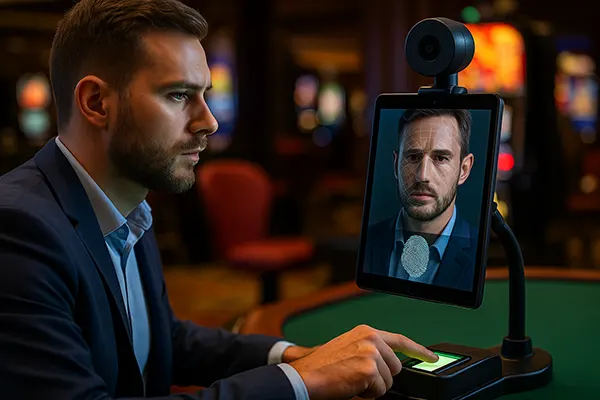
Biometric Identification of Players: Protection or Privacy Invasion?
In 2025, the integration of biometric technologies such as facial recognition (Face ID) and fingerprint scanning into gambling services has become a notable trend. Operators claim that these tools improve security, prevent fraud, and ensure compliance with age restrictions. However, concerns over data misuse and privacy remain pressing. Striking a balance between security benefits and safeguarding personal freedoms is now a focal point for both regulators and the public.
How Biometrics Helps Prevent Fraud and Underage Gambling
Biometric identification offers a powerful layer of verification that goes beyond traditional passwords or ID checks. By matching a player’s unique physical characteristics, such as their face or fingerprints, gambling operators can ensure that the person logging in is indeed the account holder. This significantly reduces account takeover incidents, bonus abuse, and other fraudulent activities that are common in the sector.
In addition, biometrics has become a key tool in combating underage gambling. Many jurisdictions require strict age verification procedures, and biometric checks make it harder for minors to access gambling services using borrowed or falsified IDs. For example, real-time facial recognition can compare a player’s face to government-issued documents to confirm their age instantly.
Several licensed gambling companies in the UK, Spain, and Sweden have adopted these systems, citing measurable reductions in fraudulent account registrations. The use of biometrics also supports responsible gambling measures, as operators can link a player’s identity to their self-exclusion records, ensuring that previously banned individuals cannot bypass restrictions.
Real-World Adoption and Effectiveness
In the UK, biometric verification is increasingly used by operators holding a Gambling Commission licence, particularly in high-stakes venues and online environments with large transaction volumes. Operators report that biometric authentication not only deters fraud but also speeds up the verification process for legitimate users, improving customer satisfaction while maintaining compliance.
In Spain, certain autonomous communities have incorporated biometric systems into physical betting shops to prevent minors and self-excluded individuals from entering. The combination of fingerprint readers and national ID databases provides an efficient and tamper-resistant method of verification.
Sweden’s Spelinspektionen authority has also encouraged operators to adopt biometric verification as part of their responsible gambling framework. Pilot studies show a notable decrease in cases where underage individuals attempted to register or gamble using someone else’s credentials.
Risks of Data Breaches and Misuse
While biometric technologies offer clear benefits, they also introduce unique risks. Unlike passwords, biometric data cannot be changed if compromised. If a database containing facial scans or fingerprints is breached, affected individuals face a permanent loss of privacy. Criminals could potentially use stolen biometric information for identity theft or to bypass security systems in other industries.
Additionally, concerns arise over potential misuse by operators or third parties. In some cases, biometric data could be used for tracking player behaviour beyond security purposes, raising ethical and legal issues. The storage, transmission, and processing of biometric data require robust encryption and adherence to strict data protection laws such as the UK GDPR.
Cybersecurity experts warn that even advanced encryption cannot fully eliminate the risk of sophisticated attacks. In 2024, a major Asian gaming company suffered a breach where partial biometric data was leaked, prompting a global debate on whether centralised biometric databases should be avoided in favour of on-device verification systems.
Balancing Security with Privacy
Industry specialists suggest adopting privacy-by-design principles, ensuring that biometric data is stored locally on a user’s device and never transmitted to central servers. This approach significantly reduces the risk of mass breaches, as hackers cannot access a large, centralised database.
Some regulators encourage operators to use multi-factor authentication, combining biometrics with other verification methods, so that no single piece of data holds the key to a user’s account. This layered security model mitigates potential damage if one factor is compromised.
Transparency is also critical. Operators must inform players exactly how their biometric data will be used, stored, and protected. Clear consent mechanisms and easy opt-out options are essential to building trust between gambling companies and their customers.

Regulatory Perspectives and Global Implementation
Regulatory bodies across the world are adopting different approaches to biometric verification in gambling. While some see it as a vital tool for consumer protection, others remain cautious, prioritising strict privacy safeguards before widespread adoption. The variation in approaches has led to a patchwork of compliance requirements for international operators.
In the European Union, biometric data is classified as “special category data” under GDPR, meaning it can only be processed under specific legal grounds. Operators must conduct Data Protection Impact Assessments (DPIAs) before implementing such systems, ensuring that the benefits outweigh potential privacy risks.
Outside Europe, countries like Australia and Canada are exploring biometric integration into gambling regulation but insist on voluntary participation and strong encryption standards. In contrast, Macau has mandated facial recognition for certain high-value transactions in casinos, citing anti-money laundering benefits.
Case Studies and Future Outlook
The UK Gambling Commission is currently evaluating pilot projects that combine biometric verification with AI-driven behaviour monitoring to detect problem gambling patterns in real time. These initiatives aim to strengthen consumer protection without overstepping privacy boundaries.
In Spain, biometric systems are now being tested in online poker rooms, allowing for instant verification without manual document checks. Early results suggest that the approach reduces onboarding time by up to 70% while improving fraud detection rates.
Looking ahead, biometric identification is expected to become more common, but its expansion will depend on striking the right balance between regulatory compliance, data protection, and user acceptance. Ongoing dialogue between operators, regulators, and privacy advocates will shape the role biometrics plays in gambling security over the next decade.





